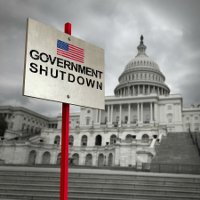|
A History of the Federal Government Shutdown
The federal government shutdown that began December 22, 2018, and ended 35 days later was the longest that the government has been shuttered. The main point of disagreement was funding for border security, specifically for a border wall that President Donald Trump wanted to build along the border between Mexico and the U.S. The Democratic-controlled House and Republican-controlled Senate could not agree with Trump on how to resolve the impasse. Passage of short-term spending bill, signed by the President, ended the shutdown. Since 1976, when Congress adopted the current budget process, the federal government has been officially shut down 21 times. On a few occasions, the shutdown lasted just one day; other times, the shutdown stretched into a second week. The annual spending for Congress must be place on October 1 of each year. If it is not, then the government is considered shut down. Technically, most of the 21 shutdowns have been considered a funding gap and not a total shutdown. Not often have all government workers been told to stay away with work and not been paid. More common have been partial shutdowns caused by disagreements on some aspects of federal funding. The first such shutdown occurred on September 30, 1976, when Congress and then-President Gerald Ford could not agree on the terms of a spending bill. Ford, a Republican, vetoed the bill, put forward by a Democratic-controlled Congress. The shutdown lasted 10 days and ended when Congress voted to override Ford's veto and the bill became law. Democrat Jimmy Carter served only one term as President but presided over five government shutdowns (all with Democrats also controlling both houses of Congress):

Republican Ronald Reagan served two terms as President and presided over eight federal government shutdowns:
George Bush, elected in 1988, was President during one shutdown, which occurred when he and the Democratic-controlled Congress could not agree on how cut to the government deficit. The three-day shutdown occurred during a federal holiday, Columbus Day, and so had limited effect. Passage of a short-term funding bill put the government back in business fully. Democrat Bill Clinton was elected President in 1992. In 1994, the Republican Party claimed both houses of Congress. Disagreements between the powers created two governmental shutdowns. The first began on November 13, 1995, and lasted five days. The entire government was shut down while Clinton and Congress battled over the size and scope of government, the possibility of a balanced budget law, and disagreements of funding for Medicare and other issues. The passage of a short-term funding bill ended the shutdown. The lack of a full-term funding bill laid the groundwork for the next shutdown, which occurred less than a month later. It began on December 15, 1995, and stretch into the new year. Both sides had the same arguments, and the government was shut down for 21 days before passage of yet another short-term funding bill opened the government again. Barack Obama was President during one of the longest shutdowns in history. For 16 days, beginning on October 1, 2013, the Republican-controlled House and Democratic-controlled Senate could not agree with Obama, a Democrat, on federal funding, primarily for the Affordable Care Act, commonly known as "Obamacare." To stop the shutdown, all sides agreed on a short-term funding bill and a raising of the debt ceiling. On January 20, 2018, disagreements over funding on immigration shut down the government for two days. The Republican-controlled House and Senate approved a short-term funding bill, which Republican President Donald Trump signed. In a tiny technicality, the federal government was partially shut down on Feb. 9, 2018, for 9 hours only, as a result of a disagreement on deficit spending in the wake of recently enacted tax cuts. A hastily approved short-term funding bill passed by Congress and signed by Trump ended the shutdown. |
Social Studies for Kids |
Social Studies for Kids
copyright 2002–2024
David White




